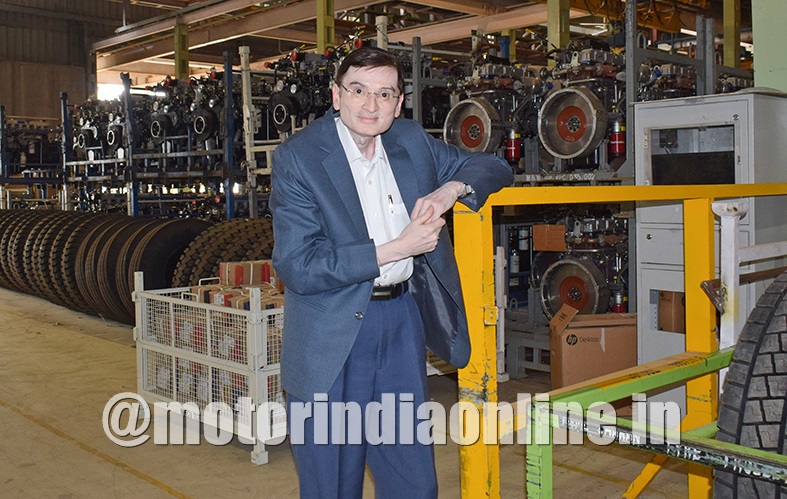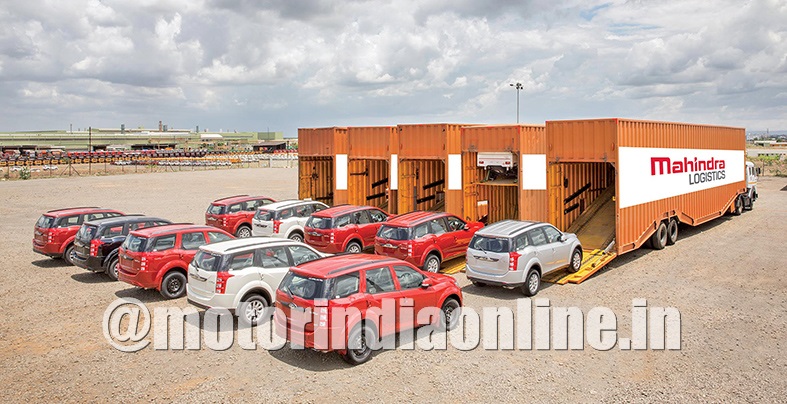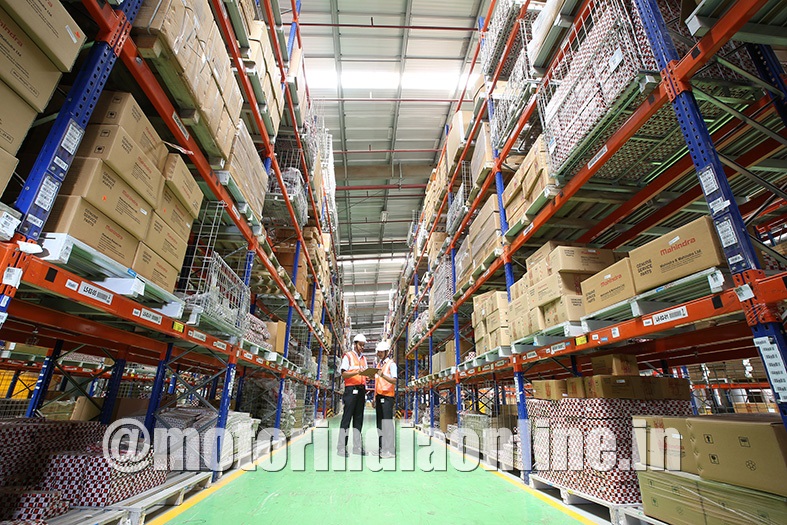Efficient logistics management can be termed a survival factor for any automotive company. Logistics plays a key role in the lifecycle of a vehicle. In fact, the Third-Party Logistics or 3PL concept has actually originated from the automotive sector. Right from shipping the components to the manufacturing plant, storing them, getting them to the assembly line and finally taking the end product to the market, it’s all about logistics.

Over the decades as automotive manufacturing has evolved, a typical automobile plant’s job is to assemble the vehicle. Everything else comes from the suppliers. Vehicle manufacturers no longer store parts in their factories. Instead, the vendor parks the parts outside, after which their logistics partner brings them to the assembly line. This makes logistics one of the key function areas today.
Mahindra Logistics Ltd. (MLL), one of India’s largest 3PL solution providers, is leading in the auto logistics space in India. Today, when the automotive industry is one of the biggest industries contributing to the world’s economy, they also have the most complex supply chain architecture. The Inbound Transportation and Production Supply Chain for Auto OEMs, Auto Component Manufacturers and Engineering companies have similar requirements although the scale and complexity differ. In order to build synergies across these two giant industry verticals, MLL made Auto & Engineering (A&E) as one integrated business vertical.
“At MLL, we offer many value-added services through our time-tested legacy in this industry like multi-modal transportation, warehousing solutions, stores and linefeed services, yard management, large contractual workforce management, just-in-time services, aftermarket logistics, return logistics, layout and process design support, among others, informed Mr. Sushil Rathi, Chief Operating Officer, Mahindra Logistics Ltd.
We spoke to Mr. Sushil Rathi to know in detail the services MLL offers in the 3PL space. Below are the edited excerpts of the same:
What are your strengths in the 3PL logistics space and what value do you add in the auto logistics space?
MLL is one of the largest 3PL logistics companies and also the largest auto logistics company in India. Having said that, we are not restricted only to auto. We operate in five different verticals, auto being one of them. We have consumer, pharma, e-commerce, bulk cargo and engineering. As the concept of 3PL logistics in India has taken a momentum only in the last 5 to 7 years, undoubtedly there is huge scope for India to have an organised professional 3PL logistics company. In the last 10-11 years of our operations in the space, we have leveraged the opportunity and have become a known name in the logistics space.
This has been possible on the back of our value-added services, innovations and our approach through which we carry out our operations. We set out to become a single source of contact for our customers and have become our preferred partners for our customers without having them run to different companies.
For e.g., we provide tyre and wheel assembly to one of India’s largest auto companies and supply on JIT basis to their plant. This goes beyond transportation. For another company we are going to assemble tractors to their forward location (stock-yards). How this solution works is that instead of moving fully-built 5-6 tractors, we remove the components like tires, wheels, chimneys and other large components and get them separately to the stockyards. This way we are able to accommodate more tractors in SKD format and later we undertake the assembly and formation of all these components at the stockyard. Not only this mechanism helps bring the logistics cost down for the customers’ but they are also able to deliver to their customers faster. These are some of the value-added services that we offer, which is very rare to be found in any other 3PL companies in India.
How has the trucking aspect change post the GST era?
A lot of changes have definitely happened post the GST era, one definitely is in the warehousing space. Now people do not need a warehouse in each and every State. People can now consolidate their warehousing to one mother warehouse or regional distribution centres (RDCs). What this has done is bring unit efficiency owing to reduced overhead cost and automation. It also has opened opportunities for a strong supply chain. The need to supply to multiple locations in Just In Time has become of utmost importance. For e.g., we are managing four and half lakh sq. ft. of warehouse for one of India’s largest FMCG companies, and from there we are delivering to other locations in just in time, which is around 300 kilometres per day, across the country.
The second change that has come is in the trucking sector. With consolidated warehousing we can move goods in higher tonnage vehicles. More goods can now move from the mother warehouses which automatically translated into reduced cost per kilometre or say cost per tonnage. The third change is the introduction of e-way bill with which the whole transactions are monitored and the traceability of movement of goods have improved leading to less congestion at the State borders. This has improved the transit time and we are able to reach faster at our destinations.
The recent norms for increased axle load must have helped too?
Yes, and the change has helped in further reducing the logistics cost. Recently, for one of the major steel manufacturers, we are deploying almost 300 to 400 trucks every day, and for them taking the advantage of the axle load increase, we made the client understand to reduce the size of their TMT bars’ bundle size so as to accommodate more packets in the truck, reducing the cost of logistics by 10% which can be passed on to the end customers.
On the trucking side, how do you manage to be asset light and still manage such a wide network of operations?
Since inception, we have been an asset light company and we have observed that many successful companies globally too have an asset light model. The purpose for us to choose and become asset light is that we are a company that do not give standard solutions to all the companies. Ours is a customised solution for the companies, and depending on the need of the customer we work out on the right truck for the customer. We have believed that if we acquire asset we would feel the constraint to give a standardized solution to our customers. For e.g., if we have hundred trucks plying between Mumbai and Delhi, we would end up reaching out to customers in these areas and ask for loads that suit our vehicles which we believe is not the right approach.
Being asset light helps us offer customisation. We go to the customers and now tell them what is your requirement and we will customise our services to your logistics need. We can find the right partner according to the customer’s requirement and not get bogged down by limitations. While we find the right partner, who plies on our route, we put our technology, our processes, our SLAs and become a single window operator on the route for the customer.
Furthermore, our solution is not limited to trucking, customers may want warehousing management from 10 different locations and then transport to a distributor and from there to the end customer (last mile). We provide a combination of solution so that they don’t have to deal with several vendors.
Another advantage is that we grow faster with this mechanism. As a truck owner you will always be constrained by your financials. For us, all the truck owners in the country are our partners. We have the business backed by processes and technology and hence can work with various truck owners.
Take us through your processes that yield successful partnerships with truck owners.
We already have the use of a few technologies like the transport management system warehousing management system and other products which are helping us to build a cohesive platform for our customers. Our right IT systems, our monetary mechanism, our review system our development with them, all form the backbone of our operations. We have a department called VA life cycle which works closely with our business partners to the extent that we visit their companies review their processes their IT systems and give them suggestion wherever required. Even if the partner works with us for 10 per cent and 90 per cent with someone else, as long as he provides us the quality as per our parameters, we have no problem in working and developing them.
Would you be able to quantify your presence across India?
Founded more than a decade ago, MLL is a portfolio company of Mahindra Partners, the $1 billion private equity division of the $20.7 billion Mahindra Group, today it serves over 350 corporate customers across various industries like Automobile, Engineering, Consumer Goods and E-commerce.
In terms of warehousing we have close to 13 million square feet of space and we do more than 80,000 trips a month. We are not into cold chain logistics as of now, but we provide cold room at warehouses if required by our customers. Another unique offering we have and that we offer to M&M at the Chakan plant is the stores and line feed. We manage 35 such plants pan-India for FMCG, pharma and consumer companies. Our next competitor might be managing around 5-7 such plants. We are ahead by leaps and bounds. We are there in the warehousing, transportation, long haul distribution the last mile and all kinds of operations, and we would like to do more of the same. While the auto sector is large for us, we have significantly diversified into other segments like e-commerce to become the largest 3PL player in the segment in India.
Our solutions, processes and our employees are our biggest assets. We have a set of 40 engineers working on the solutions and the processes specially a lot of automation requirement at the warehouses. For e.g., we are making investment of almost 10 crores for one of our e-commerce clients with respect to automation at the warehouses. These include setters, material handlers, etc., which would optimize the operations.

